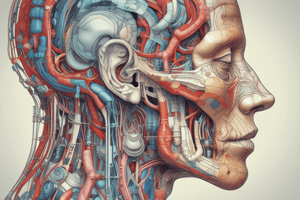Podcast
Questions and Answers
What is the role of the Central Auditory Nervous System (CANS)?
What is the role of the Central Auditory Nervous System (CANS)?
- To protect the cochlear and vestibular sections
- To make sense of the Peripheral Auditory System (correct)
- To develop the structure of the ear
- To collect sounds and transmit them to the brain
During which stage of prenatal development does most organ development occur?
During which stage of prenatal development does most organ development occur?
- Embryo (correct)
- Neonate
- Zygote
- Fetus
What is the process by which auditory placodes develop into the auricle (pinna)?
What is the process by which auditory placodes develop into the auricle (pinna)?
- Canalization from ectoderm layers (correct)
- Thickening of mesodermal tissue
- Differentiation followed by elongation
- Growth from inner ear structures
What is the role of the petrous section of the temporal bone?
What is the role of the petrous section of the temporal bone?
At what point during gestation is the tympanic membrane fully developed?
At what point during gestation is the tympanic membrane fully developed?
Which of the following statements about the auricle (pinna) is true?
Which of the following statements about the auricle (pinna) is true?
When does the canalization to form the external auditory meatus begin?
When does the canalization to form the external auditory meatus begin?
What layers contribute to the formation of the tympanic membrane?
What layers contribute to the formation of the tympanic membrane?
Flashcards are hidden until you start studying
Study Notes
Peripheral Auditory System (PAS)
- Collects sounds, travels from auditory system radiations in the brain stem into the brain.
- Hearing aids are placed in the PAS, but do not immediately improve hearing because the Central Auditory Nervous System (CANS) needs to relearn sounds.
Central Auditory Nervous System (CANS)
- Makes sense of the information from the Peripheral Auditory System.
Temporal Bone
- Located in the skull, a part of the cranium
- Contains three sections:
- Mastoid
- Squamous
- Petrous (the hardest part, protects the cochlear and vestibular sections, cannot be felt)
Prenatal Development
- Three stages:
- Zygote: Fertilization to implantation in the uterus (7-10 days). Exchange of information between egg and sperm.
- Embryo: Implantation to 5 weeks. Rapid development stage, all organs and systems are developed. The ear begins to develop.
- Fetus: 5 weeks to birth. Organs become differentiated, and physiological capabilities develop.
Outer Ear Development
- Auditory Placodes: Begin to develop from ectoderm (outer layer) between 4-6 weeks gestation.
- Auricle (pinna) develops from placodes. Formed fully by around 20 weeks.
- External Auditory Meatus (ear canal): Forms as pits develop underneath the auditory placodes and begin to canalize around 8 weeks, fully formed by around 28 weeks. Arrested development can result in inner ear issues.
Tympanic Membrane (eardrum)
- Three layers form during fetal development:
- Outer: Ectoderm
- Middle: Mesenchyme
- Inner: Endoderm
- Fully developed by 35 weeks.
Auricle (pinna)
- The most noticeable part of the outer ear.
- Shape varies from person to person.
- Made of cartilage and covered with skin continuous with the skin of the face.
- Twists, turns, and indentations help move sound through the Peripheral Auditory System.
External Auditory Meatus (ear canal)
- Tube on each side of the head, open at one end and closed at the other (quarter wave resonator).
- Starts at the Concha and ends at the Tympanic Membrane.
- Extends inward and slightly upward, forming a slight S shape.
- Lined entirely with skin, continuous with the skin from the Pinna.
- Part is cartilage, part is bone.
Tympanic Membrane
- Thin (0.07mm)
- Held in place by the Annulus (round ring of tissue).
- Two parts:
- Pars Tensa: Has three layers, the third layer allows the eardrum to vibrate.
- Pars Flaccida: Has two layers.
Studying That Suits You
Use AI to generate personalized quizzes and flashcards to suit your learning preferences.




